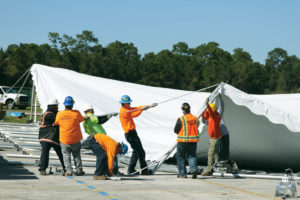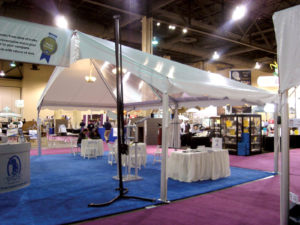
Labor is a problem everywhere, with tent rental companies experiencing constant turnover and the need to train new installers. Desperate to fill out their crews, tent renters will often send new employees on the road for installations right off the bat, with training coming on the job from long-time employees.
But just because a crew has been doing specific tasks one way for a long time doesn’t necessarily mean they are doing them the right way—that is, the safest and most efficient way that is appropriate for the product they’re installing. The practice of training on the fly can lead new crew members to pick up bad habits that can be hard to break.
Add to that the seasonal nature of tent rental, with long hours during certain times of the year. When installers are strained by the workload, there is a tendency to cut corners. There are installers who won’t put all the pins in the tent because “it takes too long.” They leave the brace bars off, with the same excuse. The problem is that the engineer who designed that tent determined that those parts are required for a structurally sound installation. A non-engineer who thinks he is qualified to decide what stays or goes in a tent is cutting corners at the expense of safety.
Basic training on tent installation encompasses three principles:
• Safety, safety, safety
• Product-specific knowledge
• Installation practices that care for and extend the life of the tent and/or equipment
One of the biggest problems I see throughout the industry is installers who are not fully trained on the products they’re using. Manufacturers owe it to their customers to train them on their specific products. And tent rental companies owe it to their employees and customers to ensure that their installations are safe and sound.
What’s at stake?
I don’t think people truly grasp how dangerous a tent can be, especially when it’s less than 100 percent installed. A tent that is installed properly is strong, durable and safe. But a tent installation in progress is unstable.
Here’s an example on pole tents: If you’re going to take a break, do it before the center pole goes into the tent, because once that happens, it’s unsafe to stop until the tent is fully tensioned, because that’s when it’s at its most dangerous point.

On a frame tent, the point between having the frame together and raising it on legs is where there is a lot of instability. This is when everybody needs to be on the same page and 100 percent focused on what has to be done. The last thing you want is for the crew to be on a bathroom or smoke break, mid-installation, and a little wind comes up at the wrong time.
Working as a team is a skill-set in and of itself. That’s why the best supervisors are those who can get synergy out of the team. Employees come from all sorts of backgrounds, and it’s naïve to expect that everybody is going to get along every day. I have a customer who says, “I don’t care if everyone gets along, you just need to work together.” Don’t bring your personal stuff on the job site, because that can affect the safety of your co-workers. Truthfully, for a lot of young employees, their maturity level doesn’t let them do that so easily. The key is educating them as to what’s at stake.
In addition, every installation needs a lead person who has the authority to stop whatever is going on. There have been bad situations in the industry over the years where installers were asked by party planners or customers to do something in a less-than-safe manner. The thing is, those people don’t understand tents. The installer has to have the authority to call the shots on a jobsite. That starts with salespeople setting expectations during the site visit. They need to let customers know up front that during the installation, if the weather conditions deteriorate to the point where they need to pull people off, that they have the authority to stop the work on the job for the safety of everyone involved.
By the book
Recently, I read an exchange on Facebook among a group of tent professionals. The original poster asked for advice regarding a situation with an upcoming installation He was getting all different kinds of recommendations, and many were incorrect and downright unsafe. Everyone was weighing in on the different ways he could achieve what he wanted. My comment was that cutting corners is going to end up damaging property or people, or both.
Most of the bigger tent manufacturers will teach their customers the things they need to know to be successful and build their business the right way. There’s a lot of bad stuff that goes on, but usually it involves the people who haven’t taken the opportunity to be educated. They can’t blame it on not having enough resources, because between the manufacturers and the trade organizations, there are plenty of places to get the training you need.
The manufacturers that don’t spend the time training customers are offering commodity products that may be simple and rudimentary in design, but can cause injuries and damage as much as a more complicated product. A 20-by-20-foot canopy that tumbleweeds across a parking lot can hurt just as much as a larger structure.
When I show up on the jobsite to train, I let my customers know right off the bat that I’m not there to make their life more difficult. I’m there to help them understand the product. I’ve learned things from customers over time that are really true labor savers, and when I share those with other customers, inevitably, I can see the bells and whistles start going off in the head of a guy who might have been initially resistant to training.
One of the best opportunities to observe textbook installation of a variety of tents is to attend IFAI Tent Expo and watch the installations in progress. At Tent Expo, all of the manufacturers install their tents by the book because so many eyes—including our competitors—are upon us.
We owe it to the industry to talk about safety. When a customer is paying a tent rental company to install a tent, it’s our duty to do the job the right way—and that starts with a crew in which everyone follows safety protocols and receives training on product-specific installation.
Bryan Bolt is technical solutions manager for TopTec Event Tents, Moore, S.C.
A few things to look for in a quality tent jack:
• A very wide base. I’ve witnessed a case with tent jacks that lacked a wide base. The wind came up just a little bit—not a lot—and pushed the tent completely off the jacks because they didn’t have the lateral stability to withstand a little bit of wind.
• A strap rather than a cable. Cables fray and end up rubbing against the tent top.
• Simple winch design. The installers are already under strain lifting the tent. The last thing they need is a complicated design that requires the manipulation of other things in that moment. In general, the more complex an item, the more parts there are to break.
• Portability—either wheels or light enough to carry.
 TEXTILES.ORG
TEXTILES.ORG


